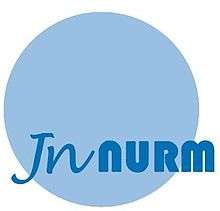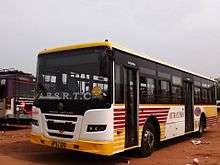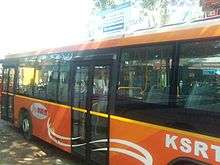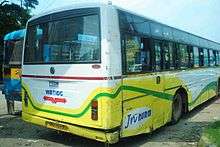Jawaharlal Nehru National Urban Renewal Mission
Jawaharlal Nehru National Urban Renewal Mission (JNNURM) was a massive city-modernisation scheme launched by the Government of India under Ministry of Urban Development. It envisaged a total investment of over $20 billion over seven years. It is named after Pt. Jawaharlal Nehru, the first Prime Minister of India .
| Jawaharlal Nehru National Urban Renewal Mission (JNNURM) | |
|---|---|
 | |
Overhead Water Tank Capacity 3 million litres, at Barat Nagar BHEL under Bhopal Municipal Corporation | |
| Country | India |
| Launched | 3 December 2005 |
| Closed | 2014 |
| Status | Succeeded by AMRUT |
The scheme was officially inaugurated by Prime Minister Manmohan Singh on 3 December 2005[1] as a programme meant to improve the quality of life and infrastructure in the cities. It was launched in 2005 for a seven-year period (up to March 2012) to encourage cities to initiate steps for bringing phased improvements in their civic service levels. The government had extended the tenure of the mission for another two years, i.emfrom April 2012 to March 31, 2014.
JNNURM was a huge mission which relates primarily to development in the context of urban conglomerates focusing to the Indian cities. JnNURM aims at creating ‘economically productive, efficient, equitable and responsive Cities’ by a strategy of upgrading the social and economic infrastructure in cities, provision of Basic Services to Urban Poor (BSUP)[2] and wide-ranging urban sector reforms to strengthen municipal governance in accordance with the 74th Constitutional Amendment Act, 1992.
Structure
Sub-missions
JnNURM primarily incorporates two sub-missions into its program:
- The Sub-Mission for Urban Infrastructure and Governance administered by the Ministry of Urban Development, with a focus on water supply and sanitation, solid waste management, road network, urban transport and redevelopment of old city areas.
- The Sub-Mission for Basic Services to the Urban Poor (BSUP)[2] administered by the Ministry of Housing and Urban Poverty Alleviation with a focus on integrated development of slums.[3]
In addition to this, it has two further components:[4]
- The Sub-Mission for Urban Infrastructure Development Scheme for Small & Medium Towns (UIDSSMT) administered by the Ministry of Urban Development, with a focus on subsuming the schemes of Integrated Development of Small and Medium Towns (IDSMT) and Accelerated Urban Water Supply Programme (AUWSP) which aim at planned urban infrastructural improvement in towns and cities under its purview.[5]
- The Sub-Mission for Integrated Housing and Slum Development Programme (IHSDP) administered by Ministry of Housing and Urban Poverty Alleviation (MHUPA) was envisaged and brought into effect in 1993–94 in accordance with providing the entire population with safe and adequate water supply facilities. The program is mainly implemented in towns with populations less than 20,000 as per the 1991 census.[6]
Objectives
- Focused attention relating to infrastructural services in the context of integrated development is to be covered under the mission.
- Make efficient and increase self-sustaining capabilities of cities as per the sector proving infrastructural services by securing the linkages between asset creation and asset management
- Ensure adequate investment of funds to fulfill deficiencies in the urban infrastructural services.
- Planned development of identified cities including peri-urban areas, out growths, urban corridors, so that urbanization takes place in a dispersed manner.
- Scale up delivery of civic amenities and provision of utilities with emphasis on universal access to urban poor.
- To take up urban renewal programme, i.e., re-development of inner (old) cities area to reduce congestion.[7]
- Provision of basic services to the urban poor including security of tenure at affordable prices, improved housing, water supply and sanitation, and ensuring delivery of other existing universal services of the government for education, health and social security.
Duration
The duration of the mission is seven years beginning from December 2005. During this period, the mission sought to ensure sustainable development of participating cities. An evaluation of the experience of implementation of the mission would be undertaken before the end of the Eleventh Five Year Plan in 2012. The duration of the mission was extended by two more years: until 31 March 2014.
funds are channelled through state-level agencies, where grants from the central and state governments are pooled and passed on as grants or soft loans to cities provided that they have prepared development strategies and that the investments identified fit within these strategies. The mission emphasises transparency and accountability. It supports public-private partnerships and cost recovery to make service providers financially self-sustaining.[3] The share of grant funding by the central government can vary from 35% in the largest cities to up to 90% in cities in the Northeast. Most cities receive grants covering 50% or 80% of costs depending on size.[8] Capacity building is also included in the mission to assist urban local bodies to prepare strategies and projects.
Currently, ten projects are covered by JNNURM funds pertaining to road network, storm water drains, bus rapid transit system, water supply, solid waste management, sewage treatment, river and lake improvement, slum improvement and rehabilitation, all fall under its scope.
Coverage
As per the JNNURM guidelines, only select cities/Urban Agglomerations (UAs) as per 2001 Census have been chosen for the implementation of the programme as per norms/criteria mentioned below:[7]
| A | Cities/UAs with 4 million plus population as per 2001 census | 07 |
| B | Cities/UAs with 1 million plus but less than 4 million population as per 2001 census | 28 |
| C | Selected cities/UAs (state capitals and other cities/UAs of religious/historic and touristic importance) | 28 |
Implementation




State level reforms
As of 2012 Gujarat led the tally for the state level reforms, being the only state to have achieved all 10 reforms required by the mission. Five states have achieved 9 out of 10 reforms: Telangana, Andhra Pradesh, Maharashtra, Madhya Pradesh, Orissa and Uttar Pradesh.[9] Public disclosure and community participation laws have initially progressed slowly, with only five states managing to enact them as part of the reform agenda as of 2009.[10] However, as of 2012 community participation laws have been enacted by 22 out of 31 states, and public disclosure laws were enacted by 27 states. 20 states had decentralised the responsibility for water supply and sanitation from the state level to ULBs, and 19 had done so for city planning functions.[9]

===City level refor of 2012, Visakhapatnam, Surat and Pune had the distinction of having accomplished all 8 city level reforms. Chennai, Greater Mumbai and Hyderabad had achieved 7 out of 8 reforms. Out of 67 cities, 30 had achieved the 90% target for property tax collection, 20 had achieved full operation and maintenance cost recovery for water supply and sanitation, but only 8 had achieved cost recovery for solid waste.[11]
Sanctioning of projects
As of 2009, 415 projects requiring an investment of ₹440 billion (US$6.2 billion), equivalent to half the total envisaged program amount, were approved. Among the states, Maharashtra has been sanctioned the maximum number of projects under the mission. Among cities, Bangalore has had the highest number of approved projects.[10]
Midterm appraisal
A midterm appraisal carried out in 2009 by the consulting firm Grant Thornton recommended to establish a single directorate for the ministries in charge of the mission; more involvement of city administrations in the preparation of city development plans that were prepared by consultants; broader stakeholder consultation during environmental and social impact assessments; the development of a national procurement manual; separation of the approval process for projects in two stages; financial support and capacity development for the implementation of reforms in addition to funding for infrastructure; the use of policies for public-private partnerships and pooled funding mechanisms at the state level, such as urban development funds that exist in Tamil Nadu and Orissa.[12]
Funding shares by city categories
| Category of Cities/Towns/UAs | Grant | ULB or Para-Statal Share/Loan from | |
|---|---|---|---|
| Centre | State | ||
| Cities/UAs with 4 million plus
population as per 2001 census |
35% | 15% | 50% |
| Cities/UAs with million plus but less
than 4 million population as per 2001 census |
50% | 20% | 30% |
| Cities/towns/UAs in North Eastern | 90% | 10% | – |
| Cities/UAs other than those mentioned above |
80% | 10% | 10% |
| For setting up de-salination plants within 20 km. From sea-shore and other urban areas predominantly |
80% | 10% | 10% |
List of identified cities
The following table provides for a list of the cities/urban agglomerations (UAs) identified to receive the benefits of JNNURM. They include data pertaining to the state they belong to; the population in these cities given in lakhs as per the census of 2001.[13]
Note: National Steering Group may choose to add or delete cities/UAs/towns under Category-C (other than state capitals) based on the suggestions received from state governments. However, the number of cities under the mission shall remain around 60.
See also
- Vikas yojna
- Accredited Social Health Activist
- Mahatma Gandhi National Rural Employment Guarantee Act
References
- "Archived copy". Archived from the original on 17 May 2012. Retrieved 2 May 2012.CS1 maint: archived copy as title (link)
- Sub-missions:JnNURM Sub-Missions Archived 10 May 2012 at the Wayback Machine
- Government of India:Jawaharlal Nehru National Urban Renewal Mission Archived 16 February 2010 at the Wayback Machine, ca. 2005
- "JNNURM Directorate" (PDF). Archived from the original (PDF) on 13 October 2011. Cite journal requires
|journal=(help) - "UIDSSMT Guidelines". Archived from the original on 5 October 2011.
- "Accelerated Urban Water Supply Programme (AUWSP)". Archived from the original on 2 November 2011.
- Guidelines:JNNURM Guidelines, February 2009
- Infrastructure Leasing & Financial Services Limited (ILFS) India:IL&FS IDC Services offered for JNNURM and UIDSSMT Schemes Archived 3 January 2010 at the Wayback Machine, undated presentation
- JnNURM. "UIG – State Level Reform Status, March 2012" (PDF). Archived from the original (PDF) on 21 September 2012. Retrieved 30 September 2012.
- Indian Infrastructure:JNNURM Progress Report, February 2009
- JnNURM UIG. "ULB Level Reforms Status, March 2012" (PDF). Archived from the original (PDF) on 21 September 2012. Retrieved 30 September 2012.
- JNNURM. "Annual Update 2010–2011" (PDF). pp. 4–5. Archived from the original (PDF) on 31 October 2012. Retrieved 30 September 2012.
- Census of India, 2001:2001 Census of India
- The Hindu, 2013:All districts to get low-floor buses
- EAI, 2012:All districts to get low-floor buses